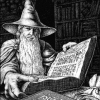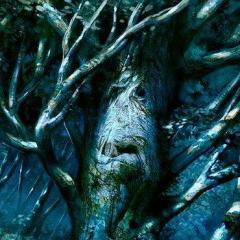Rangliste
Beliebte Inhalte
Inhalte mit der höchsten Reputation am 02.02.2025 in allen Bereichen anzeigen
-
Vor meinem geistigen Auge ist gerade ein Bild aufgeploppt, das zeigt, wie der Professor dir wegen dieser Aussage am Ohr zieht Ich kann nicht so recht erkennen, wieso eine Überlieferung der Zwerge weniger glaubwürdig sein soll als eine Überlieferung der Elben. Da sie Tolkien so wichtig ist, dass er sie bewusst in den Anhängen des Herrn der Ringe unterbringt, sollten wir sie da nicht auch ernst nehmen? Ich neige dazu, nüchtern festzustellen, dass es zwei von einander abweichende Darstellungen der Geschehnisse gibt. Genau genommen gibt es sogar noch mehr abweichende Darstellungen in anderen Texten. Vielleicht können wir darauf bei Gelegenheit noch einmal zurückkommen. Mir ging es hier aber in erster Linie um etwas anderes. Du sagst, dass „es nicht ganz so kritisch“ ist, wenn es stimmen sollte, dass Durin III. einen Ring der Macht von Celebrimbor erhielt. Für sich allein betrachtet ist das sicherlich richtig. Doch nun stammt dieser Ring aber aus der Charge der Sieben. Sollte die Übereinstimmung der Zahl der Ringe aus dieser Charge mit der Zahl der Zwergenstämme etwa rein zufällig sein? Und wieso gab Celebrimbor Durin ausgerechnet einen Ring aus dieser Charge? Auch Zufall?1 Punkt
-
Es gibt einige Stellen, die auf die Thematik eingehen, und die folgenden aus verschiedenen Büchern fassen es ganz gut zusammen: Den Wunsch der verbliebenen Eldar (oder eines signifikanten Anteils von Ihnen) nach dem Segen von Aman in Mittelerde finden wir in den Briefen: In the first [theme of the Second Age] we see a sort of second fall or at least ‘error’ of the Elves. There was nothing wrong essentially in their lingering against counsel, still sadly with the mortal lands of their old heroic deeds. But they wanted to have their cake without eating it. They wanted the peace and bliss and perfect memory of ‘The West’, and yet to remain on the ordinary earth where their prestige as the highest people, above wild Elves, Dwarves, and Men, was greater than at the bottom of the hierarchy of Valinor. They thus became obsessed with ‘fading’, the mode in which the changes of time (the law of the world under the sun) was perceived by them. They became sad, and their art (shall we say) antiquarian, and their efforts all really a kind of embalming – even though they also retained the old motive of their kind, the adornment of earth, and the healing of its hurts. –Letters: #131, late 1951 Und die Lösung für dieses Dilemma waren die Ringe der Macht, deren wichtigste Eigenschaft das Verlangsamen (oder komplette Anhalten) von Verfall war. Und auch hier zeigt sich, dass die Drei etwas Besonderes sind: Da Sauron hier unbeteiligt war, stellen sie den Wunsch der Schmiede in ihrer reinsten Form dar. Aber da sie mit den gleichen Techniken hergestellt wurden, waren sie dem Einen halt auch unterworfen: The chief power (of all the rings alike) was the prevention or slowing of decay (i.e. ‘change’ viewed as a regrettable thing), the preservation of what is desired or loved, or its semblance – this is more or less an Elvish motive. But also they enhanced the natural powers of a possessor – thus approaching ‘magic’, a motive easily corruptible into evil, a lust for domination. And finally they had other powers, more directly derived from Sauron (‘the Necromancer’: so he is called as he casts a fleeting shadow and presage on the pages of The Hobbit): such as rendering invisible the material body, and making things of the invisible world visible. The Elves of Eregion made Three supremely beautiful and powerful rings, almost solely of their own imagination, and directed to the preservation of beauty: they did not confer invisibility. – Letters: #131, late 1951 Somit wissen wir um den Sehnsuchtswunsch der Eldar (von Eregion), und jetzt kommt Sauron mit seiner Lagebeurteilung: Seeing the desolation of the world, Sauron said in his heart that the Valar, having overthrown Morgoth, had again forgotten Middle-earth; and his pride grew apace. He looked with hatred on the Eldar, and he feared the Men of Númenor who came back at whiles in their ships to the shores of Middle-earth; but for long he dissembled his mind and concealed the dark designs that he shaped in his heart Men he found the easiest to sway of all the peoples of the Earth; but long he sought to persuade the Elves to his service, for he knew that the Firstborn had the greater power; and he went far and wide among them, and his hue was still that of one both fair and wise. – Sil: Of the Rings of Power and the Third Age Hier findet sich die Ausgangssituation: Nachdem sich der Staub nach Morgoths Sturz gelegt hat, fällt Sauron wieder ins Böse zurück und plant, wie er am Besten vorgehen kann. Hierbei erkennt er ganz richtig, daß die Elben die größte Macht haben und deswegen denkt er über Wege nach, sie zu unterwerfen. Dann erscheint er in Eregion und gibt sich als Abgesandter der Valar aus: In Eregion Sauron posed as an emissary of the Valar, sent by them to Middle-earth (“thus anticipating the Istari”) or ordered by them to remain there to give aid to the Elves. – Unfinished Tales: Concerning Galadriel and Celeborn Hier spielt er seine Manipulationsfertigkeiten jetzt voll aus und sagt Ihnen, mit dem Wissen, was er zu bieten habe, können Sie beides haben: Den Segen von Valinor und das Verbleiben in Mittelerde: And he said to them [den Elben von Eregion]: “Alas, for the weakness of the great! For a mighty king is Gil-galad, and wise in all lore is Master Elrond, and yet they will not aid me in my labours. Can it be that they do not desire to see other lands become as blissful as their own? But wherefore should Middle-earth remain for ever desolate and dark, whereas the Elves could make it as fair as Eressëa, nay even as Valinor? And since you have not returned thither, as you might, I perceive that you love this Middle-earth, as do I. Is it not then our task to labour together for its enrichment, and for the raising of all the Elven-kindreds that wander here untaught to the height of that power and knowledge which those have who are beyond the Sea?” – Sil: Of the Rings of Power and the Third Age Daraufhin beginnen die Schmiede um Celebrimbor mit den Ringen: But at Eregion great work began – and the Elves came their nearest to falling to ‘magic’ and machinery. – Letters: #131, late 1951 Auch im Sil findet sich der Hinweis, daß es Saurons Ziel war, die Elben mit diesen Ringen zu unterwerfen: Therefore they [the Gwaith-i-Mírdain] hearkened to Sauron, and they learned of him many things, for his knowledge was great. In those days the smiths of Ost-in-Edhil surpassed all that they had contrived before; and they took thought, and they made Rings of Power. But Sauron guided their labours, and he was aware of all that they did; for his desire was to set a bond upon the Elves and to bring them under his vigilance. – Sil: Of the Rings of Power and the Third Age Sauron leitet die Schmiede an, um die Werkzeuge herzustellen, mit denen er die Elben knechten will. Als dies erreicht ist, verlässt er Eregion (er will ja noch seinen Meisterring machen, mit dem sein Plan dann vollendet wird): Sauron himself departed from Eregion about the year 1500, after the Mírdain had begun the making of the Rings of Power. – UT: Concerning Galadriel and Celeborn Dies ist ein entscheidender Punkt: Sauron verlässt Eregion, als er sicher weiß, dass seine Objekte zur Unterwerfung der Elben (d.h. die Sieben und die Neun) so werden, wie er es braucht. Und das geht natürlich nur, wenn diese Ringe für Elben bestimmt sind - deren Beherrschung ja sein erklärtes Ziel ist. Wären diese Ringe bereits jetzt für Menschen und Zwerge bestimmt (die ihn zu dieser Zeit gar nicht interessieren!), hätte seine Mission keinen Sinn, da er von den Drei noch gar nichts weiß (die fängt Celebrimbor ja erst nach seiner Abreise und vor allem ohne seine Mithilfe an): For long he [Sauron] paid little heed to Dwarves or Men and endeavoured to win the friendship and trust of the Eldar. – HoMe 12: Of Dwarves and Men c. 1500 The Elven-smiths instructed by Sauron reach the height of their skill. They begin the forging of the Rings of Power. c. 1590 The Three Rings are completed in Eregion. c. 1600 Sauron forges the One Ring in Orodruin. He completes the Barad-dûr. Celebrimbor perceives the designs of Sauron. – LotR: Appendix B This [the location of the Seven Rings] Celebrimbor revealed, because neither the Seven nor the Nine did he value as he valued the Three; the Seven and the Nine were made with Sauron’s aid, whereas the Three were made by Celebrimbor alone, with a different power and purpose. – UT: Concerning Galadriel and Celeborn Jetzt geht Saurons Plan aber im letzten Moment schief, da die Elben merken, was er vorhat: But the Elves were not so lightly to be caught. As soon as Sauron set the One Ring upon his finger they were aware of him; and they knew him, and perceived that he would be master of them, and of all that they wrought. Then in anger and fear they took off their rings [d.h. diejenigen der 19 Ringe, welche schon aktiv benutzt wurden]. – Sil: Of the Rings of Power and the Third Age "Gegeben" im Sinne "es wurde Ihnen gegeben" (also als Volksgruppe) wurden nur die Sieben und die Neun, da Sauron sie mit Gewalt in Besitz nahm, und dann nach seinem Ermessen an Zwerge und Menschen verteilte ("gab"). EDIT: Innerhalb der Elben wurden die Ringe ja auch "gegeben" im Sinne einer Verwahrung bzw. Hütens: Celebrimbor an Galadriel und Gil-galad, Gil-galad an Círdan und Elrond, Círdan an Gandalf.1 Punkt
Diese Rangliste nutzt Berlin/GMT+02:00 als Grundlage


